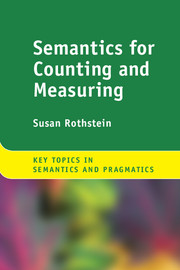Book contents
- Semantics for Counting and Measuring
- Key Topics in Semantics and Pragmatics
- Semantics for Counting and Measuring
- Copyright page
- Dedication
- Contents
- Acknowledgements
- Abbreviations
- 1 Introduction
- 2 Numericals and How They Work
- 3 Counting and Measuring
- 4 The Mass/Count Distinction
- 5 Object Mass Nouns, Measuring and Counting
- 6 A Crosslinguistic Perspective
- 7 The Universal Grinder
- 8 Classifiers
- 9 Measures
- 10 Additive and Attributive Uses of Measures
- 11 In Conclusion
- Envoi
- References
- Language Index
- General Index
- References
References
Published online by Cambridge University Press: 20 April 2017
- Semantics for Counting and Measuring
- Key Topics in Semantics and Pragmatics
- Semantics for Counting and Measuring
- Copyright page
- Dedication
- Contents
- Acknowledgements
- Abbreviations
- 1 Introduction
- 2 Numericals and How They Work
- 3 Counting and Measuring
- 4 The Mass/Count Distinction
- 5 Object Mass Nouns, Measuring and Counting
- 6 A Crosslinguistic Perspective
- 7 The Universal Grinder
- 8 Classifiers
- 9 Measures
- 10 Additive and Attributive Uses of Measures
- 11 In Conclusion
- Envoi
- References
- Language Index
- General Index
- References
- Type
- Chapter
- Information
- Semantics for Counting and Measuring , pp. 257 - 270Publisher: Cambridge University PressPrint publication year: 2017

